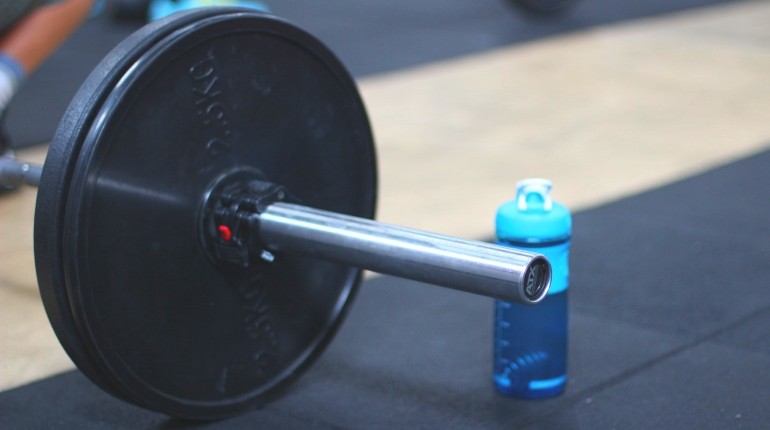How long should the breaks between sets in strength training be? This is a question that most exercisers (and coaches too) will not get a straight answer to. That’s simply because they haven’t looked at it.
Most people just take the breaks between sentences by feeling. These breaks in strength training play a role for your training progress that should not be underestimated, and if you do not deal with what is important here, you may be wasting a lot of potential. The fact is that the optimal duration of a break depends heavily on how you train and what exercises you do.
In this article I will therefore look at the use of breaks between sets in strength training. I want to explain to you why it is important that you take breaks in sentences and that they are neither too long nor too short. Then I want to give you a few guidelines on how long you should give your muscles a break between sets.
Why breaks between sets are so important in your strength training
You usually want to improve your performance through your strength training. In order to achieve this increase in performance, a sufficiently large stimulus must be set in the muscles during training. The principle for this is that the muscle should do as much physical work as possible in accordance with the target load. At the same time, the stimulus should not be too great and the muscles should not be overloaded. In addition to the training weight, the scope of the training unit and the breaks in sentences also play a decisive role.
The break between sets during strength training uses your muscles to replenish used, fast energy stores in the muscle cells. In addition, the time is also used to transport away metabolic products. As a result, the muscle regains its efficiency until it (theoretically) has reached the starting point again. This makes the break in sentences an important element of your short-term regeneration.
Most exercisers take breaks between sets, but do so based on their feelings. This often means that they don’t train with optimal break times. They either take far too long pauses between their sentences or they are so ambitious and in such a hurry that their pauses between sentences are far too short. In the following I would like to briefly explain what consequences this can have.

The dangers of short breaks in sentences
Those who have little time and / or are very motivated in their training do not want to take long breaks. I find this absolutely understandable and my breaks tend to be too short rather than too long if I don’t pay attention to them (except when I do squats ). However, this is not optimal for your training progress.
Some coaches and athletes argue that short breaks can improve strength performance and, above all, muscle growth. This is based on the finding that with shorter breaks in strength training with large weights, the release of growth hormones increases slightly if the breaks are a little shorter. If the breaks are too short, however, the negative effects outweigh.
If you take breaks in your strength training that are too short, then your muscles have no chance to recover enough to develop their full strength and thus achieve the desired level of performance. So the work done is reduced. You will then no longer manage the desired number of repetitions with the same weight. This is not helpful when it comes to increasing your muscular performance, something to build muscle .
In addition, if the breaks are too short, the risk of overload increases and, in the medium term, the risk of slipping into overtraining.
Danger of too long pauses in sentences
If you are less motivated or for whom the social component of training in the gym is earlier, the opposite is more likely to be the case. If I go to train with a good friend, it can happen to me. You talk and the pause times between sentences multiply. Sometimes this also happens to me in the home gym, e.g. when I I ran a series at the same time.
This can also otherwise occur if you walk by feeling and wait for your muscles to be completely regenerated. You wait until your muscle tells you that it can now bring full power again before you do the next set. After all, you want to use the highest possible weight again and do as many repetitions as possible. Understandable, as the training volume is an important performance indicator.
If the break in your strength training is too long, however, there is a risk that your muscles will get “cold” again. The effect of your warm-up will then be lost. This increases the risk of overloading and thus the risk of injury.
In addition, if the breaks are too long, it becomes difficult to set a sufficiently large stimulus and to create fatigue of the muscles. It is also really difficult to create the necessary scope. After all, (almost) nobody has several hours a day for their training. 😉

Your breaks should neither be too long nor be too short, so better check the clock every now and then.
How long should you take a break between sets in your strength training?
It is clear that the right length of rest plays an important role in strength training. But how long should the break between sets of strength training be so that you can achieve optimal results?
How long the optimal break between sets for your strength training is primarily depends on your training goal. If you want to train your maximum strength , then the required break will be a little longer. If you want to achieve maximum muscle growth above all, then you are probably doing hypertrophy training . This does not require very long breaks. If you want to train your strength endurance , then the required break time between sets is even less.
In the following sections, I will go into a little more detail on what are good guidelines for optimal breaks in strength training depending on the type of training.
Important: The break times mentioned below are recommendations based on current scientific knowledge and experience from the practical work of various fitness trainers. However, every person is different and every day is different. It does not make sense to stick rigidly to the guidelines without listening to your body. The figures are therefore deliberately described as corridors and are intended as a guide.
Breaks in sentences during maximum strength training
The maximum strength training requires the greatest peak performance in strength training. The pause times required between sets are correspondingly long in order to achieve this performance again. With this type of training, the muscle exhausts all short-term available energy stores. These must be replenished as far as possible in order to achieve a similar level of strength and to be able to cope with the highest possible weight.
To achieve this, you should give your body a break of at least 3 minutes between sets. Only by taking such a long break in maximum strength training can you ensure that you can go to your performance limit again.
Even if it takes a little longer with maximum strength training until the muscles cool down and many performance-oriented strength athletes (e.g. powerlifters) sometimes take longer breaks in order to be able to achieve maximum peak performance, you should not take a break of more than 5 minutes. Otherwise, returning to peak performance with cold muscles leads to a significantly increased risk of injury.
I do not do sport as a competitive sport, but see fitness as an important part of my health. So it makes little sense to risk injuries for the chance of a little more power. Nevertheless, I take 5 minutes when I work on a new record, e.g. in the deadlift try.
In addition, every training session will be damn long if you always take 10 minute breaks between sets … and who has the time for? 😉

You will only be strong like the Hulk with maximum strength training and long breaks in sentences.
Breaks between sets during hypertrophy training
Most fitness athletes practice strength training aimed at gaining muscle mass or maximizing muscle maintenance in the diet phase . The Hypertrophy Training meets the body shape that most fitness trainers nowadays strive for. In a training range of about 6-12 repetitions, the impulses for the growth of muscle volume are greatest.
With hypertrophy training, the break time required to restore the performance of the muscles is less than with maximum strength training due to the lower peak load. 1.5 to 2 minutes are usually enough here to have a worthwhile break. Experienced athletes who push their performance limits under high stress and do complex basic exercises or super sets can make their break a little longer. As a rule, however, a break of more than 3 minutes is already too long and no longer recommended.
If your goal is to build muscle, I would like to recommend my No Bullshit Guide for effective muscle building Muscle building basics at this point. Everything is summarized in a compact form and described step by step, easy to implement, which has the greatest influence on your success if you want to build muscles with a manageable effort.
Optimal set breaks for strength endurance training
Lately it has Endurance training (rightly) gained significantly in popularity. This type of training belongs in every medium to long-term training plan. Both beginners and advanced users benefit from the increase in the fatigue and injury resistance of the muscles.
When training strength endurance, the main thing is to prepare your muscles for long-lasting loads and high repetitions. The acceleration of the regeneration effects should also be trained.
In this context, a short break makes the most sense. For best results, the pause here should not last longer than 90 seconds. However, you should still take at least 20-30 seconds to allow the recovery effects to start. Personally, I always take a break of about a minute from endurance training.
The muscle group and the exercise also play a role
If you adhere to the guidelines described above for optimal break times, suitable for your type of training, you have already made an important step.
But be careful: That is not all that matters! Because the regeneration time required is not the same when training every muscle and every exercise. In complex basic exercises , in which many different muscle groups are involved, the time required for an optimal break in strength training increases. Isolation exercises with smaller muscles tend to require a slightly shorter pause in sentences.

You can use the Let the barbell sit a little longer and take a sip.
This is how you should do a shoulder press or Barbell rows should be oriented towards the upper edge of the recommended break time, while with the isolated biceps curl the optimal break is closer to the lower edge of the range.
Shorter breaks through dietary supplements?
Basically, food supplements are a sensible thing. Some, such as Creatine , can even contribute directly to an increase in performance in a healthy way. However, there is not really a sensible means of shortening the break time. If you are promised something else, I advise you to be careful!
However, what is extremely important so that the recommended break times are sufficient is that you supply your body with sufficient (micro) nutrients. For this, however, it is primarily important that you regularly eat enough fruit and vegetables and drink enough water .
If you find it difficult with the fruits and vegetables at times, you can do it like me and have a greens shake with plenty of water every morning. This gives you a small head start right after getting up. For my readers, my favorite Athletic Greens has a welcome offer with an unconditional 60-day money back guarantee: To the Athletic Greens Deal for Fitvolution readers *.
As I said, this is not an obligation if you have a very good and balanced diet, drink enough water and sleep sufficiently . 🙂
The conclusion on the pause in sentences
It is definitely very important to take a long enough, but not too long, break between sets of strength training. If you don’t do this, you risk a loss of performance, regression or even injury. All things that you certainly do not want to achieve with your training.
There are, depending on the type of training, sensible and proven guidelines that you can use as a guide. If you stick to these, you can only benefit from the benefits for your training. Of course, the other parameters of your training, your diet and your regeneration also have to be reasonably correct for these rules to work reliably. You can find all the parameters that are crucial for building muscle compactly summarized in my book Muscle Building Basics .
It is not necessary that you always have a stopwatch with you during your training from now on. Although I personally think a workout timer is a valuable tool, you don’t have to time every break exactly. It is important that you take the “optimal break times” as a guide and then also listen to your body and keep an eye on your progress in order to find out the best break times for you.

